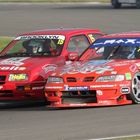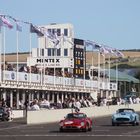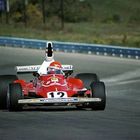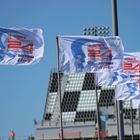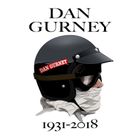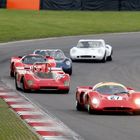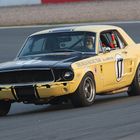Personal View: BSCC Group 1 Saloons, and Historic Rule Interpretation
- 28 Mar 2017
Share this Article
We are always keen to showcase the thoughts of anyone close to historic motorsport and Louis Quiniou has allowed us to share his blog looking at the days of Group 1 saloon racing both in period and in historic racing today:
“It’s mayhem if you actually think of what Group 1 is in historic at the moment. But it always was, even in period so history is just repeating itself I guess. But what about those so-called Group 1 “B” or Avenir cars? These are no Group 1 and rule interpretation becomes key when trying to understand these.
“Back to history, Group 1 “B” should be interpreted as Group 1 British Saloon Car Championship or the predecessor to what is today the British Touring Car Championship and Avenir is linked to the Trophée de l’Avenir which originated from the Spa 24 Hours and the Belgian seeking for a more secured approach to touring car racing in the golden seventies as fatalities and performance of these production-based cars were just going over the roof. All in all, these ruling also originated from an ever rising problem in motorsport, costs.
“But let’s stick to the British Saloon Car Championship and let’s go back to 1974 with the first year of implementation of the ruling. The Royal Automobile Club decided to walk its own way and implement a liberal interpretation of the FIA Appendix J Group 1 ruling. Basically it became what I would call the Group 1 with benefits, maybe the reason behind the category being called Group 1 “B”, who knows. And history again, years later, the Super Touring era ended with the the Brits’ going their own way again with the TOCA rules and look at how strong the Championship is compared to the WTCC…
“Back to the rules, the basics were that cars had to be homologated through the normal FIA process and minimum requirements in terms of production were retained as well as the reference to the Homologation Forms, therefore, their Variant Options, Evolutions, etc. They evolved and changed from year to year but not very much and maybe that’s the reason behind their success.
“Freedoms were given in terms of engine as “blue printing” became a given and which in situ meant that all parts could be brought to maximum homologated tolerances. Valve springs became free, camshafts too but subject to Homologation dimensions with the valve lift having to be as homologated as well.
“Ignition became free providing standard production could be retro fitted and with the exception of flywheel triggering devices. Exhaust manifolds and pipes were also let loose. Later and with emission control parts appearing in Homologations, these could be removed subject to the quantity of air admitted to the engine remaining as per the original part.
“Carburettors and intake manifolds were another big part of the freedoms given. Homologated and optional parts remained valid but it could be changed to a different manifold for fitment of any carburettor providing the original number of chokes did not exceed the maximum number originally homologated. Injection and original plenum chambers had to be as per Homologation but could be modified either in terms of cross sectional area, by upstream extension and/or reduced from the original entry to the main plenum chamber or to the first branch pipe whichever was the furthest one.
“On the car suspension almost everything was freed, alternative springs and adjustable unsprung abutments becoming a given, only for the original type of spring and number having to be maintained . Anti-roll bar diameters, mountings and material as well, providing they original mountings were still used. Damper units became unrestricted although original number and working principle remained. Geometry was also part of it with replacement and/or machining of original bushes, track becoming free providing wheels fitted within the homologated body width.
“And after all that, brakes, wheels, tyres, lubrication, cooling, electrics, transmission, fuel system, weights and a few other things became essentially ruled by the Royal Automobile Club through their blue book but always with reference to Homologation and FIA Appendix J Group 1 rules. Probably their way to try and keep it correct.
“Essentially, the BSCC rules and Trophée de l’Avenir rules were pretty close but much different, body first and with the Avenir cars first running Group 2 wheel arches and then coming back to what BSCC enforced, the homologated body width. The Brits’ were better at wording and closing doors although it did happen that a clever team or man made the most out of what was written.
“This lead the Royal Automobile Club and British Saloon Car Championship to introduce the RAC Entrants Eligibility Declarations in the last few years of the Championship. Basically, this document was a sort of specification sheet that teams had to provide to the RAC and where they would actually detail the complete used specification of the car for the particular year. A working group was behind with the sporting authority and manufacturers or team facing each others. A sort of BSCC “Homologation” which in some ways also covered very particular stuff as with the Rovers and their special period rear suspension which originated from a very clever interpretation of the rules but not everyone had it, just particular cars up to the point it went global.
“Of course, the British Saloon Car Championship produced some fantastic #TouringCarMadness with Bernard Unett, Stuart Graham, Andy Rouse, Gordon Spice, Gerry Marshall and Tony Dron amongst many others delivering some very intense and close racing. It also had its own share in making the domestic cars the best ones as the Championship did rule the American cars out from 1976 and with a capacity limit set at 3000cc up until the arrival of the Rover 3500 and British Leyland bringing that limit up to 3500cc. Brits’ are clever, always remember this.
“Talking of todays’ historic racing scene, Group 1 “B” or “Avenir” cars were recently brought back in the spotlight and this mainly through the Gerry Marshall Trophy held at the Goodwood Members’ Meeting. As well as with a few other series such as the Motor Racing Legends HTCC Tony Dron Trophy and Peter Auto Heritage Touring Cup putting these cars on the forefront of the historic racing scene.
“And last but not least, the FIA also responded by granting the permission to these cars to obtain the sacrosanct Historic Technical Passport from 01.01.2017. Not a bad move as many of the period events for these cars were run on an International Permit both in England or just considering the Trophée de l’Avenir which was in its time registered by the FIA as well as the Spa 24 Hours running to Avenir rules or combined Avenir and BSCC rules.
“However, this should not be thought as easygoing today when thinking of papers. Obtaining them will be like obtaining papers for a non-homologated car. Basically and I presume the thinking to be right, there was a base in period, the FIA Appendix J Group 1 ruling and Homologations. But these Championship or Series just went away from it and allowed practices which were not covered and it evolved from year to year as well as on specific entries as with the Spa 24 Hours. In essence, they are true Competition Touring cars, that’s all.
“So as it is said in the actual historic racing ruling get your FIA Appendix J Group 1 rules and Homologation Forms as a base, get the Championship rules and if there are any, the RAC Entrants Eligibility Declaration for the year of specification as well as a few press pictures and you should be able to cover your car.
“But as it is said in the period regulation and as it should be interpreted today, when it says free means providing it was done in period, when it says as per Homologation, this refers to the manufacturer and model as originally FIA homologated for Group 1. If far away from all that, proof will be required or maybe it was illegal already back then. Which means it cannot be done today and yes, if we are to replicate history, just make it as it was and not how you would like your car to perform.
“For reference, the FIA Appendix K and Article 7.3.6 which refers to these cars.
For Competition Touring (CT) cars of Period G onwards, built according to an ASN technical regulation for the top multi-marque National Touring Car Championship (subject to the approval of the HMSC), only the period Appendix J with amendments, period Championship regulations and original FIA Homologation Forms, with extensions and variations homologated in the period concerned, are valid. Only modifications explicitly authorised in the period regulations and legally used on the model concerned are applicable. Proof of period specification will be required for all non-homologated components and/or modifications.”
Follow Louis’ blogs on www.historicmotorsportcentral.com.
Popular Articles
March 2025 Podcast: Targa 66, Race Retro, Scalextric and Famed Journo Pete Lyons!
February 2025 Podcast: Brian Redman, the First Daytona 500, the Pick of the Ecclestone Collection and so Much More!
January 2025 Podcast -Indy Collection, Daytona and Baghettii's Debut F1 Win!
December Podcast: Derek Warwick Part Two...F1, Le Mans and More!




